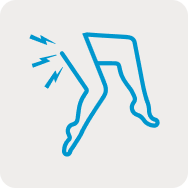
Five injuries commonly suffered by soccer players
Soccer is a true passion. Those who practice it – whether professionally or for sport – put all their efforts into being the best on the field. In their constant push to strive for victory, injuries can occur. Here are some of the most common injuries suffered by soccer players who leave everything on the field.

1. Anterior cruciate ligament (ACL) injury
The anterior cruciate ligament is one of the four ligaments of the knee. It connects the tibia bone with the femur. This injury is caused when the knee suffers a forced, unnatural movement. The ligament suffers an incomplete or total tear, causing the knee to become unstable.
The recovery from this injury is a long journey, and there are some athletes who never again achieve their highest level of play.
Some professional soccer players who have suffered this injury are the Spanish player and current coach of FC Barcelona, Xavi Hernández; Diego Costa, the Brazilian striker of the Wolverhampton Wanderers FC, ; and Radamel Falcao, the Colombian striker of Rayo Vallecano.

2. Torn meniscus
The meniscus is a cartilage located between the tibia and the femur. Its function is to cushion the knee from blows and to avoid bones rubbing together. A torn meniscus occurs when the soccer player turns the knee with force, especially when it is carrying a great deal of weight.
This is one of the most common knee injuries. It causes stiffness and difficulty in moving and extending the knee.
Some professional soccer players who have suffered this injury are the Brazilian Kaka, once considered one of the world’s top players, and Simone Zaza, the Italian forward of Torino.

3. Hamstring Strain
The hamstring muscles are located in the back of the thigh. This injury can be caused by extreme strain or stretching of the muscle when running or stopping abruptly. It results in three levels of injury: mild muscle pull or strain, partial tear, and complete muscle tear.
An injured soccer player will feel a sharp pain in the back of the thigh or a tearing sensation. It causes muscle weakness and difficulty bearing weight on the injured leg.
Professional players who have recently suffered this injury include the Argentine midfielder Leandro Paredes of Juventus and Frenchman N’Golo Kanté of Chelsea FC, both of whom will miss the Qatar championship due to injury.

4. Ankle and knee sprains
Ligaments connect bone joints providing stability and preventing the joint from over-rotation. Sprains occur when these ligaments are overstretched and tear due to a rotational movement that is too extreme.
This injury is very common, and affects players’ ankles and knees. It is usually treated with rest, ice, compression and elevation. Some injured players could face surgical intervention.
Two professional soccer players who have suffered this injury are the Portuguese Liverpool FC striker, Diogo Jota; and the Englishman Trent Alexander Arnold, also of Liverpool FC.

5. Pubalgia
Pubalgia is a chronic groin lesion caused by an imbalance of the adductor and abdominal muscles at the pubis that leads to an increase of the weakness of the groin’s posterior wall. This injury is caused by an repetitive and forceful twisting of the pelvis. The pain in the pelvis radiates to other areas, such as the adductors, abdominal muscles and crural arches.
Some professional soccer players who have suffered this injury are the Spanish player and current Bayer Leverkusen manager, Xabi Alonso; Raúl Jiménez, the Mexican player of Wolverhampton Wanderers FC; and the Spanish player, captain of FC Barcelona, Sergio Busquets.

Will my insurance cover the treatment
for these injuries?
Injuries are treated in a variety of ways depending on the severity of the damage. Treatments can range from applying compresses and rest, crutches and special bandages to physical therapy, rehabilitation therapies and surgeries.
Some VUMI® plans have coverage for injuries arising from professional sports. In addition, all plans offer physical therapy and rehabilitation services, durable medical equipment, and the option of a second medical opinion from international experts.
Contact your insurance agent or click here to learn more about our international medical insurance policies and all the benefits included in our plans.
*The article does not provide medical advice. It is intended for general informational/ educational purposes only. It is not a substitute for professional medical advice, diagnosis or treatment. Always ask your doctors or healthcare professionals for medical advice.





